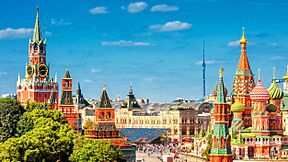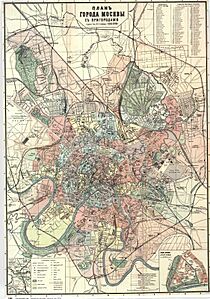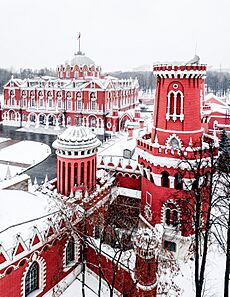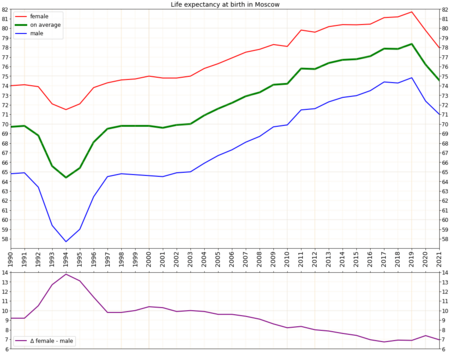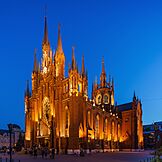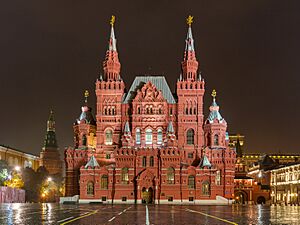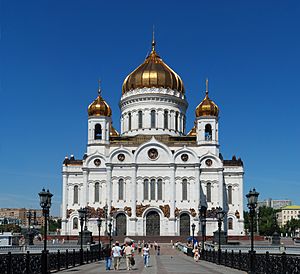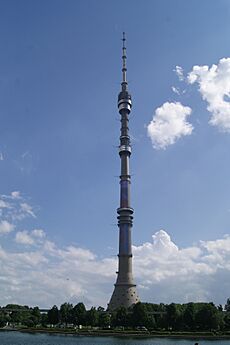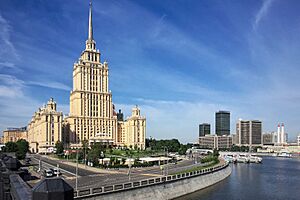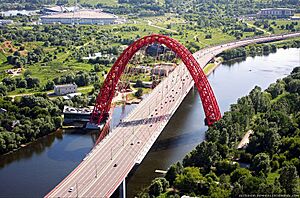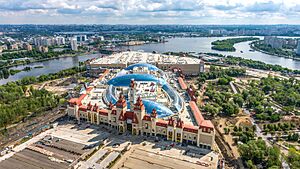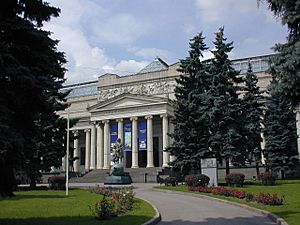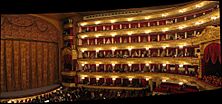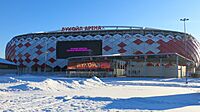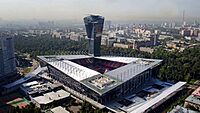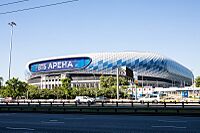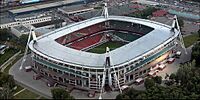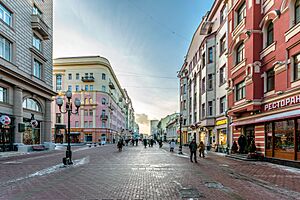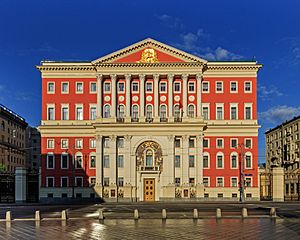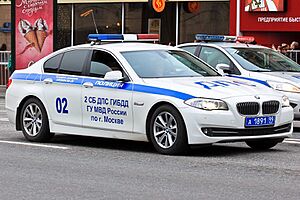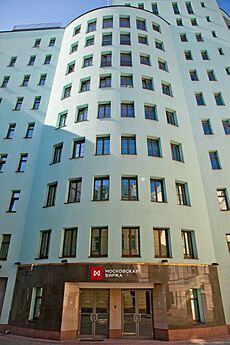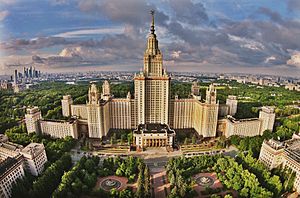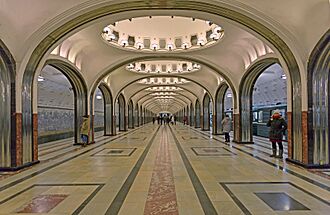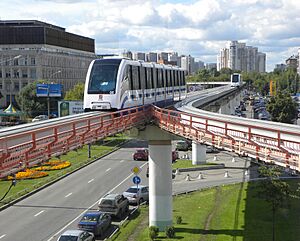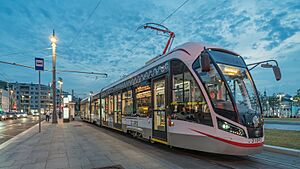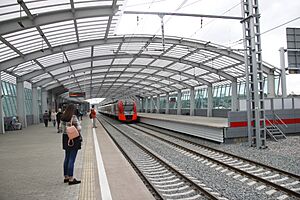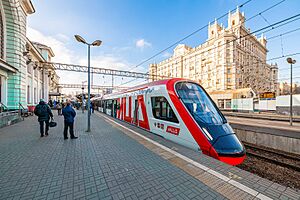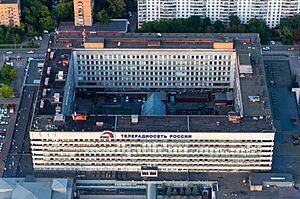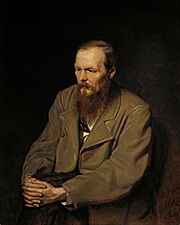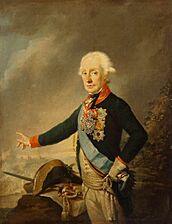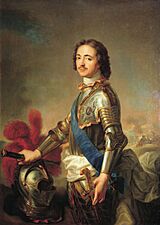Moscow facts for kids
Quick facts for kids
Moscow
Москва
|
|||
|---|---|---|---|
|
Capital city and federal city
|
|||
|
Red Square with the Spasskaya Tower (left), Saint Basil's Cathedral (right) and Ostankino Tower (background)
Cathedral of Christ the Savior
Moscow-City and Third Ring Road
Gorky Park
View along the Moskva River with the Kremlin (right) and the Moscow International Business Center (left)
|
|||
|
|||
| Anthem: "My Moscow" |
|||
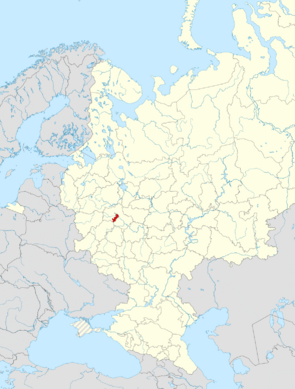 |
|||
| Country | |||
| Federal district | Central | ||
| Economic region | Central | ||
| First mentioned | 1147 | ||
| Government | |||
| • Body | City Duma | ||
| Area | |||
| • Total | 2,561.5 km2 (989.0 sq mi) | ||
| • Urban | 6,154 km2 (2,376 sq mi) | ||
| • Moscow capital region | 48,360 km2 (18,670 sq mi) | ||
| Elevation | 156 m (512 ft) | ||
| Population
(2021 Census)
|
|||
| • Total | |||
| • Rank | 1st | ||
| • Density | 5,080/km2 (13,200/sq mi) | ||
| • Urban | |||
| • Urban density | 2,762/km2 (7,150/sq mi) | ||
| • Metro | |||
| • Metro density | 450/km2 (1,200/sq mi) | ||
| Demonym(s) | Muscovite | ||
| GDP | |||
| • Federal city | ₽28.507 trillion US$412 billion (2022) |
||
| • Per capita | ₽2,182,863 US$31,528 (2022) |
||
| Time zone | UTC+3 (MSK) | ||
| ISO 3166 code | RU-MOW | ||
| Vehicle registration | 77, 177, 777; 97, 197, 797; 99, 199, 799, 977 | ||
| OKTMO ID | 45000000 | ||
| Website | mos.ru | ||
Moscow is the capital and largest city of Russia. It is located on the Moskva River in Central Russia. Moscow is a huge city, with over 13 million people living within its city limits. If you include the surrounding urban and metropolitan areas, the population grows to over 21.5 million. This makes Moscow one of the largest cities in the world. It is also the most populated city in Europe.
Moscow was first mentioned in records in 1147. It grew to become the capital of the Grand Duchy of Moscow. For most of its history, Moscow was the main political and economic center of Russia. In 1712, the capital moved to Saint Petersburg, but it returned to Moscow in 1918 after the Russian Revolution. Moscow then became the political heart of the Soviet Union. After the Soviet Union broke up, Moscow remained the capital of the new Russian Federation.
Moscow is the world's northernmost and coldest megacity. It is governed as a special federal city. It is a major global city and a very important center for politics, economy, culture, and science in Russia and Eastern Europe. Moscow has one of the world's biggest city economies. It is also a fast-growing tourist spot and one of Europe's most visited cities. Many billionaires live in Moscow, making it one of the top cities for the super-rich.
The Moscow International Business Center is a huge financial hub in Europe. It has many of Europe's tallest skyscrapers. Moscow hosted the 1980 Summer Olympics and was one of the host cities for the 2018 FIFA World Cup.
Moscow is home to many famous Russian artists, scientists, and athletes. It has many museums, schools, and theaters. The city has several World Heritage Sites recognized by UNESCO. It is known for its amazing Russian architecture, especially places like Red Square and buildings like Saint Basil's Cathedral and the Moscow Kremlin. The Kremlin is where the Government of Russia works. Moscow has many Russian companies and a great public transport system. This includes four international airports, ten train stations, a tram system, a monorail, and the Moscow Metro. The Metro is the busiest in Europe and one of the largest rapid transit systems in the world. Over 40 percent of Moscow is covered by green spaces, making it one of the greenest cities in the world.
Contents
- What Does the Name "Moscow" Mean?
- Moscow's Long History
- Moscow's Location and Climate
- Who Lives in Moscow?
- Moscow's Look and Landmarks
- Moscow's Road System: The Rings
- Moscow's Culture and Fun
- How Moscow is Governed
- Moscow's Economy
- Learning in Moscow
- Getting Around Moscow
- Media in Moscow
- Famous People from Moscow
- Moscow's International Connections
- Images for kids
- See also
What Does the Name "Moscow" Mean?
The name of the city, Moscow, probably comes from the Moskva River. Experts believe the river's name might come from an old word meaning "wetland" or "marsh." This makes sense because the area used to be quite wet.
Other Names for Moscow
Moscow has been given several special nicknames over time. People have called it "The Third Rome" and the "First Throned." It is also one of twelve Hero Cities, a title given for bravery during World War II. People who live in Moscow are called Muscovites.
Moscow's Long History
Early Beginnings of Moscow
Archaeologists have found signs that people lived in the Moscow area a very long time ago, even before recorded history. The first known mention of Moscow was in 1147. It was a small town then. In 1156, a wooden wall was built around the town, which became the first Kremlin. Sadly, in 1237, the Mongols attacked and burned the city.
Moscow as a Grand Duchy

After the Mongol invasion, Moscow slowly grew stronger. Prince Daniel, the youngest son of Alexander Nevsky, inherited the small fort in the 1260s. He helped Moscow become a rich city. By the 1320s, Moscow was more important than its parent principality.
Moscow became a safe and wealthy place, attracting people from all over Russia. In 1380, Prince Dmitry Donskoy of Moscow led a Russian army to a big victory over the Mongols. This helped Moscow become the leader in freeing Russia from Mongol rule. By 1480, Ivan III had fully freed Russia from the Tatars. Moscow then became the capital of a growing empire.
Ivan III rebuilt the Moscow Kremlin in the 15th century. He invited Italian architects to design new walls, towers, and palaces. The famous Red Square also appeared around this time.
Moscow as the Tsardom's Capital
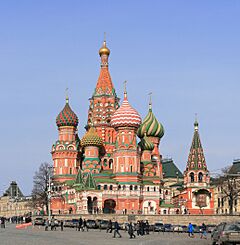
In the 16th and 17th centuries, Moscow built more circular defenses. However, fires often destroyed parts of the city. In 1571, the Crimean Tatars attacked and burned almost everything except the Kremlin. Only 30,000 out of 200,000 people survived. New walls were built to protect the city.
Between 1610 and 1612, Polish-Lithuanian troops took over Moscow. But Russian cities united and drove them out. In 1613, Michael Romanov became tsar, starting the Romanov dynasty. In 1712, Peter the Great moved the capital to Saint Petersburg. Moscow was no longer the main capital for a while.
Moscow in the Russian Empire
After losing its capital status, Moscow's population dropped. But after 1750, it grew a lot, reaching 1.8 million by 1915. In the 18th century, permanent street lights were added, and cobbled roads were built.
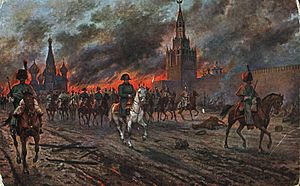
In 1812, when Napoleon invaded Russia, Moscow was evacuated. A big fire destroyed much of the city. This fire, along with the harsh Russian winter, forced Napoleon's army to retreat. After the fire, Moscow was rebuilt. Important buildings like the Grand Kremlin Palace and the Bolshoi Theatre were reconstructed. Moscow State University was founded in 1755.
Moscow in the Soviet Era
In November 1917, after the revolution, Moscow became the capital again. The Kremlin once more became the center of power for the new Soviet state. During this time, many churches were destroyed as part of a new anti-religious policy.
During World War II, Moscow was a key target. In 1941, German forces tried to capture the city in the Battle of Moscow. Muscovites helped build defenses, and the city was bombed. But the German army was stopped and pushed back. Moscow was given the title of "Hero City" in 1965 for its bravery.
After the war, Moscow faced a housing shortage. Many high-rise apartment buildings were built quickly to house the growing population. The Moscow Ring Road (MKAD) was opened in 1961, marking the city's administrative boundary for many years. In 1980, Moscow hosted the 1980 Summer Olympics. In 1991, Moscow was the scene of a coup attempt against Mikhail Gorbachev's reforms.
Moscow Today (1991–Present)
After the dissolution of the Soviet Union in 1991, Moscow remained Russia's capital. A market economy brought many new businesses and modern buildings. The city continued to grow rapidly. In 2012, Moscow's area more than doubled by expanding into the Moscow Oblast. This made Moscow the largest city in Europe by land area. Many old churches and historical buildings that were destroyed in Soviet times have been rebuilt.
Moscow's Location and Climate
Where is Moscow Located?
Moscow sits on the banks of the Moskva River, which flows through central Russia. The city has 49 bridges over the river and its canals. Moscow is about 156 meters (512 feet) above sea level. The highest point in the city is Teplostan Upland, at 255 meters (837 feet). Moscow stretches about 39.7 kilometers (24.7 miles) from west to east and 51.8 kilometers (32.2 miles) from north to south.
Moscow's Climate and Weather

Moscow has a humid continental climate. This means it has long, cold winters and warm summers. Winters usually last from mid-November to the end of March. Temperatures can change a lot, from very cold (around -25°C or -13°F) in winter to warm (around 20-26°C or 68-79°F) in summer. Sometimes, during heat waves, summer temperatures can go above 30°C (86°F).
The highest temperature ever recorded in Moscow was 39.0°C (102.2°F) in July 2010. The lowest was -42.1°C (-43.8°F) in January 1940. Snow usually starts falling in mid-October and stays on the ground from late November to the end of March. Moscow gets about 1731 hours of sunshine each year. The city center is often warmer than the suburbs, especially in winter.
| Climate data for Moscow (VVC) normals 1991–2020, records 1879–present | |||||||||||||
|---|---|---|---|---|---|---|---|---|---|---|---|---|---|
| Month | Jan | Feb | Mar | Apr | May | Jun | Jul | Aug | Sep | Oct | Nov | Dec | Year |
| Record high °C (°F) | 8.6 (47.5) |
8.3 (46.9) |
19.7 (67.5) |
28.9 (84.0) |
33.2 (91.8) |
34.8 (94.6) |
38.2 (100.8) |
37.3 (99.1) |
32.3 (90.1) |
24.0 (75.2) |
16.2 (61.2) |
9.6 (49.3) |
38.2 (100.8) |
| Mean daily maximum °C (°F) | −3.9 (25.0) |
−3 (27) |
3.0 (37.4) |
11.7 (53.1) |
19.0 (66.2) |
22.4 (72.3) |
24.7 (76.5) |
22.7 (72.9) |
16.4 (61.5) |
8.9 (48.0) |
1.6 (34.9) |
−2.3 (27.9) |
10.1 (50.2) |
| Daily mean °C (°F) | −6.2 (20.8) |
−5.9 (21.4) |
−0.7 (30.7) |
6.9 (44.4) |
13.6 (56.5) |
17.3 (63.1) |
19.7 (67.5) |
17.6 (63.7) |
11.9 (53.4) |
5.8 (42.4) |
−0.5 (31.1) |
−4.4 (24.1) |
6.3 (43.3) |
| Mean daily minimum °C (°F) | −8.7 (16.3) |
−8.8 (16.2) |
−4.2 (24.4) |
2.3 (36.1) |
8.1 (46.6) |
12.2 (54.0) |
14.8 (58.6) |
13.0 (55.4) |
8.0 (46.4) |
3.0 (37.4) |
−2.4 (27.7) |
−6.5 (20.3) |
2.6 (36.7) |
| Record low °C (°F) | −42.1 (−43.8) |
−38.2 (−36.8) |
−32.4 (−26.3) |
−21 (−6) |
−7.5 (18.5) |
−2.3 (27.9) |
1.3 (34.3) |
−1.2 (29.8) |
−8.5 (16.7) |
−20.3 (−4.5) |
−32.8 (−27.0) |
−38.8 (−37.8) |
−42.1 (−43.8) |
| Average precipitation mm (inches) | 53 (2.1) |
44 (1.7) |
39 (1.5) |
37 (1.5) |
61 (2.4) |
78 (3.1) |
84 (3.3) |
78 (3.1) |
66 (2.6) |
70 (2.8) |
52 (2.0) |
51 (2.0) |
713 (28.1) |
| Average extreme snow depth cm (inches) | 24 (9.4) |
35 (14) |
29 (11) |
2 (0.8) |
0 (0) |
0 (0) |
0 (0) |
0 (0) |
0 (0) |
0 (0) |
4 (1.6) |
12 (4.7) |
35 (14) |
| Average rainy days | 8 | 6 | 9 | 15 | 16 | 16 | 15 | 16 | 16 | 17 | 13 | 8 | 155 |
| Average snowy days | 25 | 23 | 15 | 6 | 1 | 0 | 0 | 0 | 0.3 | 5 | 17 | 24 | 116 |
| Average relative humidity (%) | 85 | 81 | 74 | 68 | 67 | 72 | 74 | 78 | 82 | 83 | 86 | 86 | 78 |
| Mean monthly sunshine hours | 33 | 72 | 128 | 170 | 265 | 279 | 271 | 238 | 147 | 78 | 32 | 18 | 1,731 |
| Percent possible sunshine | 14 | 27 | 35 | 40 | 53 | 53 | 52 | 51 | 38 | 24 | 13 | 8 | 34 |
| Average ultraviolet index | 0 | 1 | 2 | 3 | 5 | 6 | 6 | 5 | 3 | 1 | 1 | 0 | 3 |
| Source 1: Pogoda.ru.net, Thermograph.ru, Meteoweb.ru (sunshine hours) | |||||||||||||
| Source 2: Weather Atlas (UV) | |||||||||||||
| Climate data for Moscow (VVC) normals 1961–1990 | |||||||||||||
|---|---|---|---|---|---|---|---|---|---|---|---|---|---|
| Month | Jan | Feb | Mar | Apr | May | Jun | Jul | Aug | Sep | Oct | Nov | Dec | Year |
| Mean daily maximum °C (°F) | −6.3 (20.7) |
−4.2 (24.4) |
1.5 (34.7) |
10.4 (50.7) |
18.4 (65.1) |
21.7 (71.1) |
23.1 (73.6) |
21.5 (70.7) |
15.4 (59.7) |
8.2 (46.8) |
1.1 (34.0) |
−3.5 (25.7) |
8.9 (48.0) |
| Daily mean °C (°F) | −9.3 (15.3) |
−7.7 (18.1) |
−2.2 (28.0) |
5.8 (42.4) |
13.1 (55.6) |
16.6 (61.9) |
18.2 (64.8) |
16.4 (61.5) |
11.1 (52.0) |
5.1 (41.2) |
−1.2 (29.8) |
−6.1 (21.0) |
5.0 (41.0) |
| Mean daily minimum °C (°F) | −12.3 (9.9) |
−11.1 (12.0) |
−5.6 (21.9) |
1.7 (35.1) |
7.6 (45.7) |
11.5 (52.7) |
13.5 (56.3) |
12.0 (53.6) |
7.1 (44.8) |
2.0 (35.6) |
−3.3 (26.1) |
−8.6 (16.5) |
1.2 (34.2) |
| Climate data for Moscow (2014–2024, VVC) | |||||||||||||
|---|---|---|---|---|---|---|---|---|---|---|---|---|---|
| Month | Jan | Feb | Mar | Apr | May | Jun | Jul | Aug | Sep | Oct | Nov | Dec | Year |
| Mean daily maximum °C (°F) | −4.2 (24.4) |
−1.6 (29.1) |
4.3 (39.7) |
11.7 (53.1) |
19.3 (66.7) |
22.9 (73.2) |
24.4 (75.9) |
23.7 (74.7) |
17.0 (62.6) |
8.7 (47.7) |
1.8 (35.2) |
−2 (28) |
10.5 (50.9) |
| Daily mean °C (°F) | −6.2 (20.8) |
−3.7 (25.3) |
0.8 (33.4) |
7.3 (45.1) |
14.1 (57.4) |
17.7 (63.9) |
19.6 (67.3) |
18.8 (65.8) |
13.0 (55.4) |
6.3 (43.3) |
0.3 (32.5) |
−3.4 (25.9) |
7.1 (44.8) |
| Mean daily minimum °C (°F) | −7.9 (17.8) |
−5.8 (21.6) |
−2.7 (27.1) |
2.9 (37.2) |
8.9 (48.0) |
12.5 (54.5) |
14.9 (58.8) |
13.9 (57.0) |
9.1 (48.4) |
3.8 (38.8) |
−1.2 (29.8) |
−4.7 (23.5) |
3.6 (38.5) |
| Mean monthly sunshine hours | 37 | 65 | 142 | 213 | 274 | 299 | 323 | 242 | 171 | 88 | 33 | 14 | 1,901 |
| Source: weatheronline.co.uk | |||||||||||||
Who Lives in Moscow?
Moscow's Population Growth
| Historical population | ||
|---|---|---|
| Year | Pop. | ±% |
| 1897 | 1,038,625 | — |
| 1926 | 1,995,252 | +92.1% |
| 1939 | 4,141,633 | +107.6% |
| 1959 | 5,045,905 | +21.8% |
| 1970 | 6,941,961 | +37.6% |
| 1979 | 7,830,509 | +12.8% |
| 1989 | 8,769,117 | +12.0% |
| 2002 | 10,382,754 | +18.4% |
| 2010 | 11,503,501 | +10.8% |
| 2021 | 13,010,112 | +13.1% |
| Population size may be affected by changes in administrative divisions. Source: Censuses |
||
In 2021, Moscow's population was over 13 million people. This number has grown a lot over the years.
Different Ethnic Groups in Moscow
Moscow is a diverse city with many different ethnic groups. Most people are Russians. Other groups include Tatars, Armenians, Ukrainians, and Azerbaijanis, among others.
Religion in Moscow
| Religion in Moscow (2020) | ||||
|---|---|---|---|---|
| Russian Orthodoxy | 55% | |||
| Atheism and irreligion | 28% | |||
| Islam | 8% | |||
| Other religions | 3% | |||
| Other Christians | 2% | |||
| Undeclared | 4% | |||
Most people in Moscow are Christian, mainly following the Russian Orthodox Church. The head of the church, the Patriarch of Moscow, lives in the Danilov Monastery. Before 1917, Moscow was known for having many churches.
Other religions practiced in Moscow include Islam, Judaism, and Buddhism. There are four mosques in the city.
Moscow's Look and Landmarks
Amazing Architecture in Moscow
Moscow is famous for its architecture. It is home to Saint Basil's Cathedral with its colorful onion domes, the Cathedral of Christ the Savior, and the Seven Sisters skyscrapers. The first Kremlin was built in the 12th century.
Moscow's old design had circular walls and roads spreading out from the center. This pattern, along with the rivers, shaped how the city looks even today. The Kremlin was rebuilt in the 15th century by Italian architects. This gave the city a touch of the Renaissance.
In the 18th century, many wooden houses were replaced with buildings in the classical style. During Soviet times, especially under Joseph Stalin, Moscow's look changed a lot. Wide avenues were built, but many historical buildings were torn down. Many churches were destroyed because the government was against religion. However, the Kazan Cathedral and the Cathedral of Christ the Savior were rebuilt in the 1990s.

The Seven Sisters are seven huge skyscrapers built during the Stalin era. They have a unique style with spires and are a key part of Moscow's skyline. The Ostankino Tower, completed in 1967, was once the tallest freestanding structure in the world.
After the Soviet era, many old apartment buildings were built to house the growing population. These buildings are often tall and have elevators. Moscow has more elevators than New York City and Chicago combined.
Many buildings from the Tsarist era can still be found in the city center. The Old Arbat Street is a famous tourist street with many buildings from before the 20th century. Some old noble estates and monasteries are also open to visitors.
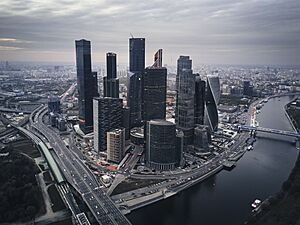
Moscow's skyline is becoming more modern with new towers. However, some people are concerned that too many historical buildings are being destroyed or rebuilt without keeping their original value. Groups like the Moscow Architecture Preservation Society are working to protect these old buildings.
Parks and Famous Places
Moscow is a very green city. It has 96 parks and 18 gardens, including four botanical gardens. About 450 square kilometers (170 square miles) of the city are green zones. Moscow has about 27 square meters (290 square feet) of parks per person, which is much more than cities like Paris or London.
Gorky Park, founded in 1928, is a famous park along the Moskva River. It has attractions, ponds, and sports facilities. It connects to the Neskuchny Garden, Moscow's oldest park.
Izmaylovsky Park, created in 1931, is one of the largest urban parks in the world. It is six times bigger than Central Park in New York.
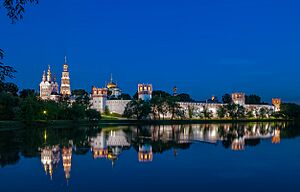
Sokolniki Park is another old park, named after the falcon hunting that used to happen there. It has a central circle with a fountain and many tree-lined paths.
Losiny Ostrov National Park ("Elk Island" National Park) is Russia's first national park. It is very wild, and you can even see elk there.

The Main Botanical Garden is the largest in Europe. It has over 20,000 types of plants from all over the world.
The All-Russian Exhibition Center (VDNKh) is a huge park with many detailed pavilions. Each pavilion used to represent a part of Soviet industry or a Soviet republic. It has impressive fountains like the Stone Flower.
Moscow has many famous attractions. The Moscow Kremlin and Red Square are UNESCO World Heritage Sites. The Church of the Ascension at Kolomenskoye, built in 1532, is also a UNESCO World Heritage Site.
Near the new Tretyakov Gallery is a sculpture garden called Museon. It displays statues from the former Soviet Union that were removed after it dissolved.
The Moscow Zoo is a popular place with almost a thousand different animal species. Many of Moscow's parks are protected natural areas.
Moscow's Road System: The Rings
Moscow's roads are built around the Kremlin in the city center. Roads generally spread outwards and connect with several circular roads, known as "rings."
- The first main ring is the Boulevard Ring. It follows the path of an old 16th-century city wall. It's not a full circle, but a horseshoe shape.
- The second main ring is the Garden Ring. It also follows the path of an old city wall.
- The Third Ring Road was finished in 2003. It's a high-speed highway.
- The Moscow Ring Road (MKAD) is the outermost ring within Moscow. It was built in the 1950s and used to be the city's boundary.
The Moscow Metro also has a circular line, called the Koltsevaya Liniya (Ring Line), which runs between the Garden Ring and the Third Transport Ring.
In 2016, the Moscow Central Circle (Line 14) opened. It's a renovated railway that forms another circle around historical Moscow. Another circular metro line, the Big Circle Line, is also being built.
Outside Moscow, some roads continue this circular pattern, like the Betonka roads. A new outer ring road, the CKAD, is being built to help reduce traffic on the MKAD.
Transport Rings in Moscow
| Length | Name | Type |
|---|---|---|
| 9 km | Boulevard Ring – Bulvarnoye Koltso (not a full ring) | Road |
| 16 km | Garden Ring – Sadovoye Koltso ("B") | Road |
| 19 km | Koltsevaya line (Line 5) | Metro |
| 35 km | Third Ring Road – Third Transport Ring – Tretye Transportnoye Koltso (TTK) | Road |
| 54 km | Little Ring of the Moscow Railway, re-opened as Moscow Central Ring (MCC) – Line 14 | Railway |
| 20.2 km | Bolshaya Koltsevaya line – Line 11 | Metro |
| 109 km | Moscow Automobile Ring Road – Moskovskaya Koltsevaya Avtomobilnaya Doroga (MKAD) | Road |
Moscow's Culture and Fun
Museums and Art Galleries
One of Moscow's most famous art museums is the Tretyakov Gallery. It has two buildings. The Old Tretyakov Gallery shows classic Russian art, including works by famous painters like Ilya Repin and old icon painters like Andrei Rublev. The New Tretyakov Gallery mainly features Soviet artists and some modern art.
Another important art museum is the Pushkin Museum of Fine Arts. It has exhibits on world civilizations, with copies of ancient sculptures. It also displays paintings from different Western art periods, including works by Claude Monet and Pablo Picasso.
The State Historical Museum of Russia tells the story of Russian history. It has millions of items, from ancient relics to artworks from the Romanov dynasty. The Polytechnical Museum is the largest technical museum in Russia. It shows many historical inventions and technological achievements. The Borodino Panorama museum lets visitors experience a battlefield with a 360° diorama.
Performing Arts and Entertainment
Moscow is a major center for performing arts, especially ballet and film. It has 68 museums, 103 theaters, 132 cinemas, and 24 concert halls. The Bolshoi Theatre is one of the most famous.
The Moscow International Performance Arts Center, also known as Moscow International House of Music, is known for classical music concerts. It has the largest organ in Russia.
Moscow also has two large circuses: Moscow State Circus and Moscow Circus on Tsvetnoy Boulevard.
The Mosfilm studio has produced many classic films. International film festivals like the Moscow International Film Festival are held in Moscow.
Sports in Moscow
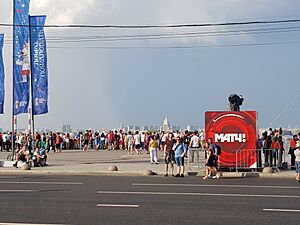
Over 500 Olympic sports champions lived in Moscow by 2005. The city has 63 stadiums, including the Luzhniki Stadium, which is the largest in Moscow and the 4th biggest in Europe. It hosted events for the 1980 Summer Olympics and the 2018 FIFA World Cup.
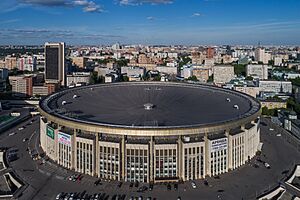
Moscow was the host city for the 1980 Summer Olympics. It also bid for the 2012 Summer Olympics but did not win.
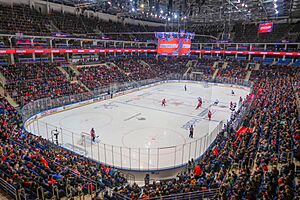
Moscow is home to many successful sports teams. In ice hockey, HC CSKA Moscow is one of the most successful teams in the world. In basketball, PBC CSKA Moscow is a top club in Europe. Moscow has also had many winners in chess championships.
In football, FC Spartak Moscow has won the most championship titles in the Russian Premier League. PFC CSKA Moscow was the first Russian team to win a UEFA title, the UEFA Cup. Other professional football teams in Moscow include FC Lokomotiv Moscow, FC Dynamo Moscow, and FC Torpedo Moscow.
-
Lukoil Arena, home of FC Spartak Moscow.
-
VEB Arena, home of PFC CSKA Moscow.
-
VTB Arena, home of FC Dynamo Moscow and HC Dynamo Moscow.
-
RZD Arena, home of FC Lokomotiv Moscow.
Moscow also has the Irina Viner-Usmanova Gymnastics Palace, a modern facility for gymnastics. Because of Moscow's cold climate, winter sports are popular. Many parks offer trails for skiing and frozen ponds for skating.
Moscow hosts the annual Kremlin Cup, a popular tennis tournament. The city also hosted the Eurovision Song Contest 2009.
Football Clubs in Moscow
| Club | Founded | League | League Rank | Stadium |
|---|---|---|---|---|
| Spartak Moscow | 1922 | Premier League | 1st | Lukoil Arena |
| CSKA Moscow | 1911 | Premier League | 1st | VEB Arena |
| Lokomotiv Moscow | 1923 | Premier League | 1st | RZD Arena |
| Dynamo Moscow | 1923 | Premier League | 1st | VTB Arena |
| Torpedo Moscow | 1924 | First League | 2nd | Eduard Streltsov Stadium |
| Rodina Moscow | 2015 | First League | 2nd | Spartakovets Stadium |
| Veles Moscow | 2016 | Second League | 3rd | Avangard Stadium |
Shopping and Nightlife
Moscow has many clubs, restaurants, and bars. Tverskaya Street is one of the busiest shopping streets. The nearby Tretyakovsky Proyezd has luxury stores. Moscow's Nightlife has grown a lot, with many large nightclubs. The area around the old chocolate factory is a popular spot with bars, clubs, and cafes.
Dream Island is a large indoor theme park that opened in Moscow in 2020. It looks like a fairytale castle and has 29 attractions, shops, and restaurants.
How Moscow is Governed
Moscow's City Government
Moscow is a special federal subject of Russia, meaning it's like its own region. The Mayor of Moscow is the main leader of the city government. The Moscow City Duma is the city council that approves local laws. It has 45 members elected for five-year terms.
The city is divided into twelve administrative districts and 125 smaller districts. Each district has its own symbols and leaders.
Federal Government in Moscow
Moscow is also where most of Russia's federal government is located. The Government of the Russian Federation is in the White House. The State Duma (one part of the Russian parliament) and the Federation Council (the other part) are also in Moscow. The Supreme Court is here too.
The Moscow Kremlin is the official home of the President of Russia.
Safety in Moscow
Moscow is considered a safe city. In 2019, it ranked 37th safest in a global study. The city has over 170,000 surveillance cameras connected to a facial recognition system. This system helps keep the city safe.
The emergency numbers in Moscow are: 112 for all emergencies, 101 for fire and emergency situations, 102 for police, 103 for ambulance, and 104 for gas emergencies. Moscow's emergency medical services are very efficient.
Moscow's Economy
Economic Overview
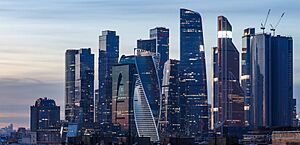
Moscow has one of the largest city economies in Europe. It makes up more than one-fifth of Russia's total economic output. The average monthly salary in Moscow is about twice the national average.
Moscow has the third-highest number of billionaires in the world and the most in Europe. It is Russia's financial center, home to the country's biggest banks and companies like the oil giant Rosneft. Moscow accounts for a large part of Russia's retail sales and construction. The economy has grown a lot in recent years, with many new business centers being built.
Main Industries in Moscow
Moscow's main industries include chemicals, metallurgy, food, textile, furniture, energy production, software development, and machinery.
The Mil Moscow Helicopter Plant is a top producer of helicopters. The Khrunichev State Research and Production Space Center makes space equipment, including parts for the ISS. Famous aircraft design bureaus like Sukhoi and Ilyushin are also in Moscow.
Many major Russian companies have their headquarters in Moscow, including Gazprom, the world's largest natural gas extractor. Moscow is also home to many telecommunications and technology companies like Kaspersky Lab and Yandex. Some industries are moving out of the city to help improve the environment.
Learning in Moscow
Schools and Universities
Moscow has many schools and universities. There are 1,696 high schools and 91 colleges. It also has 222 higher education institutions, including 60 state universities. The Lomonosov Moscow State University, founded in 1755, is one of the most famous. Its main building is 240 meters (787 feet) tall. The university has over 30,000 undergraduate and 7,000 postgraduate students. Its library has over nine million books, making it one of the largest in Russia. Many international students come to Moscow State University to learn Russian.
The I.M. Sechenov First Moscow State Medical University is a large medical university. The Pirogov Russian National Research Medical University is another important medical school, known for being the first university in Russia to allow women to get degrees.
Moscow also has excellent business schools and technical universities like Bauman Moscow State Technical University, founded in 1830.
The Moscow Conservatory, founded in 1866, is a famous music school. Many famous composers and musicians have studied there.
The Gerasimov Institute of Cinematography (VGIK) is the world's oldest film school, founded in 1919. Famous filmmakers like Sergei Eisenstein and Andrei Tarkovsky were professors or graduates there.
The Moscow State Institute of International Relations is Russia's best-known school for international relations and diplomacy.
Science and Libraries
Moscow is a major science center in Russia. The headquarters of the Russian Academy of Sciences are located here. Many important research institutions, like the Kurchatov Institute (for nuclear energy), are also in Moscow.
The city has 452 libraries. The Russian State Library, founded in 1862, is the national library of Russia. It is one of the largest libraries in the world, with over 42 million items in many languages. The State Public Historical Library specializes in Russian history.
Getting Around Moscow
Moscow Metro: An Underground Art Gallery
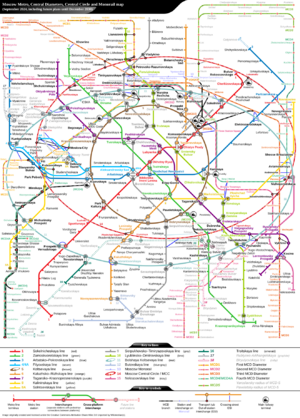
The Moscow Metro system is famous for its beautiful art, murals, mosaics, and fancy chandeliers. It opened in 1935 and quickly became the main way to get around. Many of the original stations were designed like grand art installations. For example, the Elektrozavodskaya station is themed after a lightbulb factory.
Today, the Moscow Metro has twelve lines and 203 stations. It is one of the deepest subway systems in the world. The Park Pobedy station, for instance, is 84 meters (276 feet) underground and has the longest escalators in Europe. The Moscow Metro is the busiest metro system in Europe, carrying about 10 million passengers every day. Moscow is always expanding its Metro system. In 2016, a new circular railway was opened to help with traffic.
Newer metro stations continue the tradition of unique designs. The Moscow Metro also offers free WiFi and USB charging ports.
Moscow Monorail
The Moscow Metro also runs a short monorail line (Line 13). It connects the Timiryazevskaya metro station with Ulitsa Sergeya Eisensteina, passing near the VDNH. The monorail opened in 2004.
Buses, Trolleybuses, and Electric Buses
Moscow has a large bus network that connects to metro stations and residential areas. There is a main bus terminal for long-distance buses.
Moscow used to have the largest trolleybus system in the world. However, the city is now replacing trolleybuses with electric buses. Moscow aims to be a leader in electric and gas-powered public transport. All bus stations and terminals in Moscow now have free Wi-Fi.
Moscow Cable Car
In November 2018, a cable car opened over the Moskva River. It connects the Luzhniki sports complex with Sparrow Hills. The ride takes only five minutes. The cable car is 720 meters (2,360 feet) long and can carry 1,600 passengers per hour. The cabins have media screens, LED lights, and audio guides in several languages.
Trams in Moscow
Moscow has a large tram system that started in 1899. Trams are important for connecting different parts of the city and linking to metro stations. There are three main tram networks in Moscow.
New tram models have been developed for Moscow, even though the network hasn't expanded much recently.
Taxis and Sharing Systems
Commercial taxi services are widely used in Moscow. Companies like Yandex.Taxi, Uber, and Gett are very popular. Yandex is even testing self-driving taxis in Moscow.
Moscow also has many vehicle sharing options. It has the largest fleet of carsharing vehicles in the world, with over 30,000 cars. There are also bike sharing services like Velobike and electric scooter sharing services like Delisamokat.
Trains and Railway Stations
Moscow has ten main train stations, called vokzals. These stations are located near the city center and connect to the metro. Each station handles trains from different parts of Europe and Asia. Train tickets are usually cheap, making trains a popular way to travel, especially to Saint Petersburg. Moscow is also the western end of the Trans-Siberian Railway, a very long train route that goes across Russia to Vladivostok.
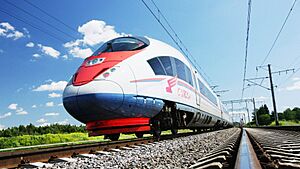
Suburbs and nearby cities are connected by a network of electric commuter trains called elektrichkas.
Moscow Central Circle (MCC)
The Moscow Central Circle (MCC) is a 54-kilometer (34-mile) urban railway line that goes around historical Moscow. It opened in 2016 and is part of the Moscow Metro system (Line 14). You can use your Moscow Metro tickets on the MCC.
Moscow Central Diameters (MCD)
The Moscow Central Diameters (MCD) is a new railway system that connects suburbs through Moscow's center. The first two lines opened in 2019. These trains are designed for suburban and city travel.
Roads and Traffic
Moscow has over 2.6 million cars every day. This causes a lot of traffic jams and makes parking difficult. The Moscow Ring Road (MKAD) and the Third Transport Ring are the main highways within the city.
Airports Serving Moscow
There are five main airports that serve Moscow: Sheremetyevo (SVO), Domodedovo (DME), Vnukovo (VKO), Zhukovsky (ZIA), and Ostafyevo (OSF).
Sheremetyevo is the most connected airport for international flights. Domodedovo is the busiest for overall passengers and domestic flights. Vnukovo handles flights from various airlines. Ostafyevo is mainly for business flights.
Water Transport
Moscow has two passenger terminals on the river, the South River Terminal and North River Terminal. You can take ship routes and cruises along the Moskva and Oka rivers, mostly for fun. There are also three freight ports for cargo.
Future Plans for Moscow

Since 1992, Moscow has been planning a new business district called the Moscow International Business Center (MIBC). The goal is to create a zone with businesses, homes, and entertainment. It's being built on the Krasnopresnenskaya embankment. The Federation Tower, completed in 2016, is the second-tallest building in Europe. The MIBC will have a water park, offices, homes, and a new location for the Moscow government. New metro stations and a train shuttle to Sheremetyevo International Airport are also planned.
In 2021, the cellphone company MTS started testing the country's first 5G network in Moscow.
Media in Moscow
Moscow is home to almost all of Russia's national television networks, radio stations, newspapers, and magazines.
Newspapers
English-language newspapers include The Moscow Times and Moscow News. Russian-language newspapers like Kommersant and Vedomosti are leading business newspapers.
TV and Radio
Other media in Moscow include Echo of Moscow, a private news radio station, and NTV, one of the first privately owned Russian television stations. There are nearly 50 radio stations in Moscow.
Moscow television networks:
- Channel One
- Russia-1
- NTV
- TV Tsentr
- Rossiya Kultura
- Russia-24
- Public Television of Russia
- REN TV
- STS
- TNT
- TV-3
- Zvezda
- Domashny
- Carousel
- Pyatnica!
- Disney Channel
- RBC
- Moskva 24
- Dozhd
- RU.TV
Moscow radio stations:
- "Russian (Russkoye) Radio"
- "Europa Plus"
- "DFM"
- "NRJ (Russia)"
- "Radio Maximum"
- "Voice of Russia (in English)"
- "Radio Freedom (Svoboda)"
- "Megapolis FM"
- "Radio Kultura (Culture)"
- "Pioneer FM"
- "Zvezda"
- "Komsomolskaya Pravda"
- "Orpheus"
- "Monte Carlo"
- "Love Radio"
- "The Main" Главная
- "Govorit Moskva"
- "Radio Dacha"
- "Nashe Radio"
- "Radio 7"
- "Humor FM"
- "Retro FM"
- "Ultra"
- "Keks FM"
- "Carnival"
- "Dobrye Pesni (Good Songs)"
- "Voyage FM"
- "Kino FM"
- "Finam FM"
- "First Popular"
- "Politseiskaya Volna (Police Wave)"
- "Radio Sport"
- "Radio Rossii"
- "Radio Podmoskovye"
- "Radiocompany Moscow"
- "UFM"
- "Mayak"
- "Business FM"
- "Autoradio"
- "Moya Semia (My Family)"
- "XFM"
- "Fresh Radio"
- "Silver Rain"
- "Chanson"
- "M-Radio"
- "Orphey"
- "Echo of Moscow"
- "Radio Jazz"
- "Classic Radio"
- "Vesti FM"
- "City FM"
- "Relax FM"
- "Kommersant FM"
- "Rock FM"
- "Children's Radio"
- "Radio Alla"
- "Best FM"
- "Next FM"
- "Hit FM"
- "Radio Record"
- "Capital FM Moscow"
Famous People from Moscow
-
Alexander Pushkin, the founder of modern Russian literature, was born in Moscow in 1799.
-
Fyodor Dostoyevsky was born in Moscow in 1821.
-
Alexander Suvorov was born in Moscow in 1730.
-
Peter the Great was born in Moscow in 1672.
Moscow's International Connections
Sister Cities Around the World
Moscow has "sister city" relationships with many cities around the world. This means they share cultural and economic ties.
- Almaty, Kazakhstan
- Ankara, Turkey
- Astana, Kazakhstan
- Baku, Azerbaijan
- Bangkok, Thailand
- Beijing, China
- Berlin, Germany
- Bucharest, Romania
- Buenos Aires, Argentina
- Cusco, Peru
- Dubai, United Arab Emirates
- Ganja, Azerbaijan
- Ho Chi Minh City, Vietnam
- Jakarta, Indonesia
- Ljubljana, Slovenia
- London, United Kingdom
- Manila, Philippines
- New Delhi, India
- Pyongyang, North Korea
- Rasht, Iran
- Reykjavík, Iceland
- Riga, Latvia
- Seoul, South Korea
- Tashkent, Uzbekistan
- Tehran, Iran
- Tokyo, Japan
- Ulaanbaatar, Mongolia
Cooperation Agreements
Moscow also has special cooperation agreements with other cities:
Past Sister Cities
Some cities have ended their sister city relationships with Moscow.
- Brno, Czech Republic
- Chicago, United States
- Düsseldorf, Germany
- Kharkiv, Ukraine
- Kyiv, Ukraine
- Prague, Czech Republic
- Tallinn, Estonia
- Vilnius, Lithuania
- Warsaw, Poland
Images for kids
-
The Kremlin in the late 16th century.
-
Moskva riverfront in the 19th century.
-
Moscow as viewed from the International Space Station, January 29, 2014.
-
As of 2020[update], Moscow has the largest fleet of carsharing vehicles in the world.
See also
 In Spanish: Moscú para niños
In Spanish: Moscú para niños


